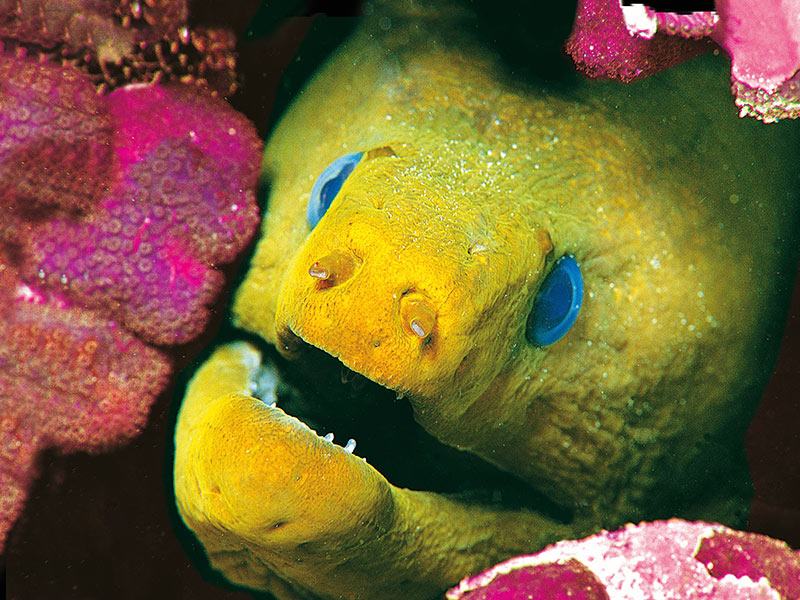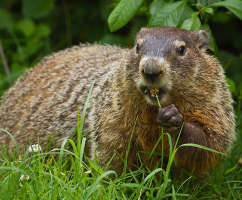Top 10 Predators of Sea Urchins that Eat Sea Urchins
The sea urchins are undersea creatures from the family Echinoidea. Their name derives from the Old French word "herichun," which once referred to the hedgehog ... read more...that lives on the ground. In other words, a sea urchin is similar to a sea hedgehog since it has spines all over its body to ward off potential predators. Here are the top predators of sea urchins that eat sea urchins.
-
The northern and eastern shores of the North Pacific Ocean are home to these marine animals. Sea otters are the largest members of the weasel family; at maturity, they typically weigh between 14 and 45 kg, can walk on land, and only exist in the waters. Their incredibly thick fur serves as their primary form of insulation. These species were formerly thought to number between 150,000 and 300,000, but between 1741 and 1911, they were intensively killed for their fur, and their numbers decreased to between 1,000 and 2,000.
The sea otters live in areas close to the coast, where it forages by diving to the ocean floor. It mostly preys on fish species as well as numerous mollusks, crustaceans, and marine invertebrates like sea urchins. Its feeding and foraging behaviors are notable in a number of ways. It is one of the few mammal species that uses tools because it cracks open shells and uses pebbles to dislodge prey. It is a keystone species over the majority of its range, regulating sea urchin populations that would otherwise cause serious harm to kelp forest ecosystems. They break apart and even displace the shells of their prey using rocks as tools. They are keystone species because they control the sea urchin population, which would have caused serious harm to the kelp forest ecosystems.

Photo: The Bay Area Monitor - Sea Otter 
Photo: ThoughtCo - Sea Otter -
Crabs are crustaceans that can survive in both marine and terrestrial habitats. They are members of the suborder Brachyura. These creatures, which have a strong exoskeleton formed of mineralized chitin, are particularly skilled at surviving severe settings. They are very swift and agile, and because of their modified legs, they can walk sideways with ease. Crabs must continue to molt repeatedly after being juveniles in order to reach adulthood. They have a thick shell covering them since doing without would stop them from growing. Hormones work together to regulate the molt cycle. The old shell softens and partially erodes in preparation for molting, while the foundational layers of a new shell develop underneath.
But the crab's strong pair of pincers is what makes it unique as a predator of sea urchins. These crab legs, also known as chelas, are thought to have a specific purpose. These work well for both feeding and defense for them.
Fresh crabs are well-suited to overcome the sea urchin's defenses because of their hard shells and strong pincers. The crab's claws allow it to quickly crush the sea urchin's outer body after it has gained a grip.

Photo: Newsweek - Crab 
Photo: AZ Animals - Crab -
A subfamily of the wrasses, the parrot fishes are a group of roughly 90 different fish species. The Indo-Pacific region has the highest species richness for this group, with roughly 95 species. They can have a big impact on bioerosion and may be found in seagrass beds, rocky beaches, and coral reefs.
The dentition of parrot fishes, which is unique from that of other fish, including other labrids, has given them their name. With their parrot-like beaks, they rasp algae off coral and other rocky surfaces. Their many teeth are placed in a closely packed mosaic on the outside surface of their jaw bones. Their group, which includes around 90–95 species, contributes significantly to bioerosion. Some species, which are mostly herbivores and eat epilithic algae, may even grow to lengths of over one meter.
They occasionally eat microscopic creatures like bacteria, crustaceans, and debris. The green humphead parrotfish is one of its biggest kinds, and it mostly eats polyps and live coral. Even while they don't only eat corallivores, polyps may make up as much as half of their diet. With the exception of the green humphead parrotfish, all of them choose algae-covered surfaces over living corals. They could be seen consuming marine urchins as well.
Video: SZtv - Parrotfish: Buck-Toothed and Beach-Building Beauties! 
Photo: Aquariadise - Green Parrot Fish -
Nephropidae is the family of marine crustaceans that includes lobsters. These creatures have elongated bodies coated in a hard exoskeleton that is designed to shield them from potential predators. Lobsters reside in cracks or burrows on the ocean floor and have long, muscular bodies. On rocky, sandy, or muddy bottoms from the seashore to beyond the edge of the continental shelf, lobsters may be found in all oceans. Typically, they dwell alone in rock caves or burrows. Additionally, these sea urchin predators have distinctive claws on their front legs that they utilize for hunting and self-defense.
Pereiopods are creatures with very strong claws. Many lobsters have asymmetrical claws, with the "crusher" being the bigger and more powerful of the two. These are designed specifically for crushing their prey, with spherical abnormalities covering the pincer claws. The other claw has sharpened edges designed for ripping apart prey.
Due to their chitinous shell, lobsters, like fresh crabs, are protected from the sea urchin's poisonous spines. Because the sea urchins' internal organs are protected by a hard shell, the lobsters are now free to capture them in their strong pincers. Actually, this predator is more than a match for the sea urchin.
Video: Free High-Quality Documentaries - Lobsters - The armoured knights of the oceans 
Photo: MarvelVietnam - Lobster -
Octopuses are eight-limbed, soft-bodied mollusks that are members of the Octopoda order. Their habitat spans a variety of aquatic environments, including ocean waters, the seafloor, and coral reefs. These are often young, swiftly growing, and immature species. When fully grown, they typically weigh between 14 and 16 kg, and they can have arms as long as 14 feet. They are dangerous creatures, although only the poison of the blue-ringed octopuses can kill people; they normally avoid humans, but occasional contacts have been documented.
Occupying dens, which are often cracks in rocky outcrops or other solid objects, octopuses conceal themselves. However, other species dig into sand or mud. Octopuses are not territorial, however they usually stay in their home zone. They may venture outside if they need to find food. Without having to go back the way they came, they may find their way to a den. These animals don't migrate.
Octopuses transport their prey to their den so they may securely consume it there. When the octopus catches more prey than it can consume, a midden of dead and uneaten food is frequently present around the den. Younger ones often eat copepods, sea stars, and crab larvae, whilst adults prefer tiny fish, snails, crabs, clams, and other octopuses.
Sea urchin consumption by octopuses is uncommon, but when alternative food sources aren't accessible, they'll eat everything they can.
Photo: Encyclopedia Britannica - octopus 
Photo: Exhibit Galleries Blog -
The Balistidae family of fish includes a sizable number of brilliantly colored fish, including the triggerfish. A few, like the oceanic triggerfish (Canthidermis maculata), are pelagic, but the majority are found in relatively shallow, coastal settings, particularly on coral reefs. Even though a few members of this family are common in marine aquarium commerce, they are frequently renowned for having bad tempers. When defending their eggs, certain triggerfish species can become highly combative. When a diver encounters an angry triggerfish, it is preferable to swim horizontally away from the nest site since their domain spreads in a cone shape from the nest toward the surface. Swimming upwards can place a diver more into the fishes' territory. In contrast to the Picasso triggerfish, which is relatively tiny, the titan triggerfish is much larger and has more powerful teeth, which makes it a major hazard to careless divers.
An aggressive predatory fish is the triggerfish. They are also thought to be more intelligent than fish and capable of learning from past errors. In addition to this, they have a robust jaw and teeth that are specially designed to break through hard shells.
One of the frequent predators of sea urchins and other comparable bottom-dwelling marine creatures is the triggerfish. A triggerfish may readily surpass the sea urchin's defenses due to its extreme aggression. They can each take out a few of the sea urchin's protective spines before they can bite right into its body.
Photo: Dreamstime.com - Giant Titan Triggerfish Video: Oceana - Meet the aggressive, territorial triggerfish -
One of the predators of sea urchins that eat sea urchins, not to be missed is the California sheephead.
A kind of vibrantly colored fish native to the Pacific Ocean is called the California sheephead. These hermaphrodite fish, which are well-known for inhabiting the Gulf of California, all give birth to females first. As they grow and change into males, they also change to acquire a distinctively huge black head and black tail.
The fish have a very strong site attachment, and their home ranges are rather restricted. Due to the intricacy of their environment, which has grown, they may favor rocky places with kelp more frequently. These sites probably provide more options for foraging and might serve as a haven from huge predators. Sheephead are typically seen of as being mostly connected with rocky reefs and kelp beds, however they occasionally visit sand areas during foraging excursions. They are predatory fish that like to hunt for prey on the seafloor. Undoubtedly, sea urchins are their most frequent prey. The body of a sea urchin may be crushed within the mouths of California sheepheads thanks to their strong set of chitinous teeth. They are so strong that among their other favourite food are even crabs and other crustaceans.

Photo: iStock - California Sheephead 
Photo: Kayak Fishing Accessories - California Sheephead -
Few pufferfishes species are on the list of the world's most venomous vertebrates, although pufferfishes are generally toxic. The liver and skin of certain of its species contain tetrodotoxin, which is extremely harmful to most animals when consumed. However, China, Korea, and Japan regard its flesh as a delicacy. They are typically tiny to medium in size, although some of their species may grow more than 50 cm. Although they are not present in cold water, they are quite varied there and rather uncommon in temperate regions.
Their normal diet consists mostly of insects and algae. Large ones may even contain clams, mussels, and shellfish. They will cheerfully eat a sea urchin if they come find one. Depending on their surroundings, pufferfishes can have a variety of diets. Their traditional diet consists primarily of tiny invertebrates and algae. If their habitat is resource-poor, they can subsist entirely on a vegetarian diet, but they prefer an omnivorous diet. Larger species of pufferfishes may crack open clams, mussels, and other shellfish with the help of their front teeth, which resemble beaks. Some pufferfishes species have also been observed using a variety of hunting strategies, from ambushes to open-water hunts.

Photo: iStock - Pufferfish 
Photo: Earth.com - Pufferfish -
A member of the Perciformes order, the wolf eel is a marine species that is unique to the North Pacific Ocean. Wolf eels, which may grow up to seven feet long, often live in couples as mates in underwater rock caves.
One of the most menacing-looking underwater predators is the wolf eels. They have a blank, threatening expression that is horrifyingly scary. Their intimidating moniker comes from the intimidating prey they hunt and consume with their strong jaws and fangs. It has 233 radials but no rays in the anal fin. It only has one dorsal fin, which is made up of 228 to 250 flexible fishbones without soft radius and runs from the head to the end of the body.
With its powerful jaws, this fish with an eel-like appearance feeds on various fish species as well as invertebrates with hard shells (crustaceans, sea urchins, mussels, and clams). In captivity, it has been seen that when given soft food, like squid, they prefer it to hard food, which might harm their rear teeth. The body of a sea urchin may fit completely inside the eel's jaws. They then continue to crush the sea urchins' outer body with their strong bit and pointed teeth. Their strong teeth may break even lobsters or crabs with tough shells. Beware, sea urchins!
Video: Oregon Zoo - Meet Blanche the Wolf Eel 
Photo: Dreamstime.com - Wolf Eels -
One of the predators of sea urchins that eat sea urchins is moray eels.
Members of the moray eel family may be found all over the world. There are over 200 species in 15 genera, all of which are mostly marine. Both freshwater and saltwater ecosystems are home to moray eels. Most species are exclusively marine and never venture into freshwater. The most well-known of the few freshwater species is Gymnothorax polyuranodon. Their bodies are often patterned, and some species' mouth inside are as well.
Just beyond the skull, down the back, the dorsal fin connects smoothly with the caudal and anal fins. Most species have a serpentine look due to the absence of pectoral and pelvic fins. Because of their tiny eyes, moray eels largely rely on their highly developed sense of smell when waiting in ambush for food.
Moray eels are opportunistic carnivorous predators that mostly eat smaller octopuses, fish, and crabs. A spotted moray eel was once seen devouring a red lionfish. It has been noted that wandering coral groupers connected to the reef would lure giant morays into their nets. They also consume sea urchins, cuttlefish, and squid.
Photo: Oceanarium Bournemouth - Moray Eel 
Photo: Biology Dictionary - Moray Eel































